Flyfishing on Rivers in Ireland
With literally hundreds of lakes, rivers and streams that contain stocks of wild brown trout (but no grayling!), Ireland is a trout flyfisher's paradise. In a few places there are also sea trout, although nowhere in Ireland rivals the rivers of West Wales.
Salmon fishing in Ireland is relatively inexpensive - although the best beats of the River Moy and the River Blackwater can hardly be called cheap, but when on form they do offer good fishing.
River Fergus
The Fergus rises in the Burren, Europe’s largest area of limestone pavement and famous for its unique communities of Atlantic and Arctic-alpine plants. The river runs clear as it wanders very slowly through Kilnaboy, Corofin, Ennis and Newmarket-on-Fergus before entering the tidal Shannon. On its way the Fergus passes through Inchiquin Lake in the upper reaches and Ballyallia Lake, a wildfowl sanctuary just north of Ennis. En-route several other small lakes contribute a rich source of food for the trout of the Fergus.
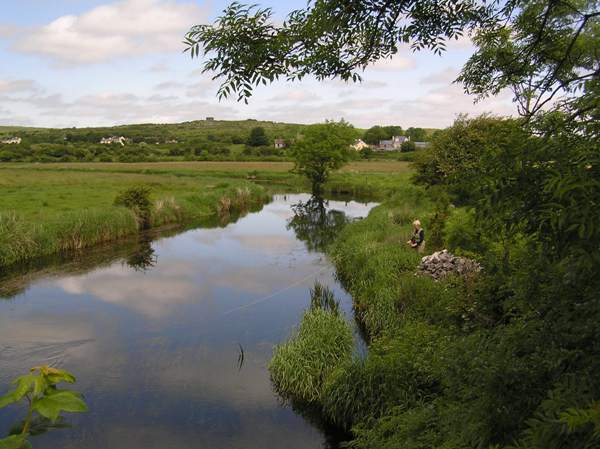
Sue Parker fishing for brown trout on the River Fergus
Trout Fishing
Trout of the Fergus grow deep and fat on a rich diet of insects and freshwater shrimps. Plenty of adult trout habitat and limited spawning and nursery area ensures that each fish has lots of space and no real competition for food. Their growth rate is high: next to none of the protein input is wasted in holding station, because the Fergus rarely does more than saunter along.
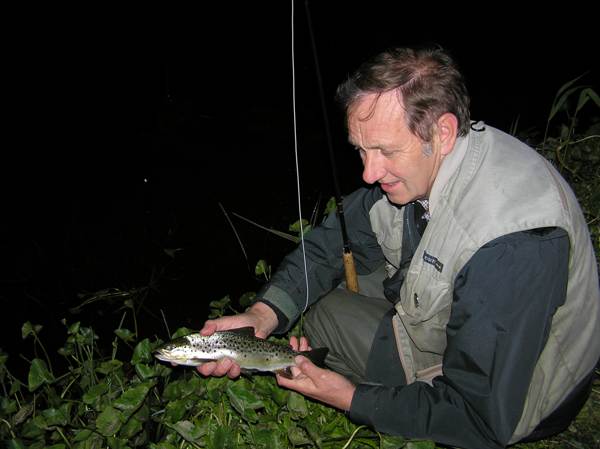
Fergus trout often have golden flanks
A #4 or #5 fly rod and matching floating line is ideal for this narrow but in places quite deep river. Fish dry flies in spring and on summer evenings, but we find that nymphing is the best method to use on sunny summar days; a size 16 heavily-weighted nymph fished as a 'dropper' beneath a buoyant dry fly is our preferred technique at such times.
What to Expect
In summer the water level is held up by dense weed growth that makes anything but dry fly fishing next to impossible over most of the journey to the tidal Shannon below Ennis. A 5lb tippet is not unreasonable in such a snag-rich environment, and the river taught soon taught us that degreasing the tippet so that it sinks is the very least we must do to fool a Fergus fish. Spring fishing can be quite productive during the day, but if you catch two or three fish in a summer's evening you are doing well. the good news is that the fish grow big in this rich river, and four-pound trout will take dry flies in springtime. The local record, a trout caught near Corofin, easily topped the ten-pounds mark.
River Boyne
The Boyne flows some 112 kilometres (70 miles) from Trinity Well, near Carbury in County Kildare, and flows to the Irish Sea between Mornington, in County Meath, and Baltray,in County Louth. This limestone river is famous mainy for its trout fishing.
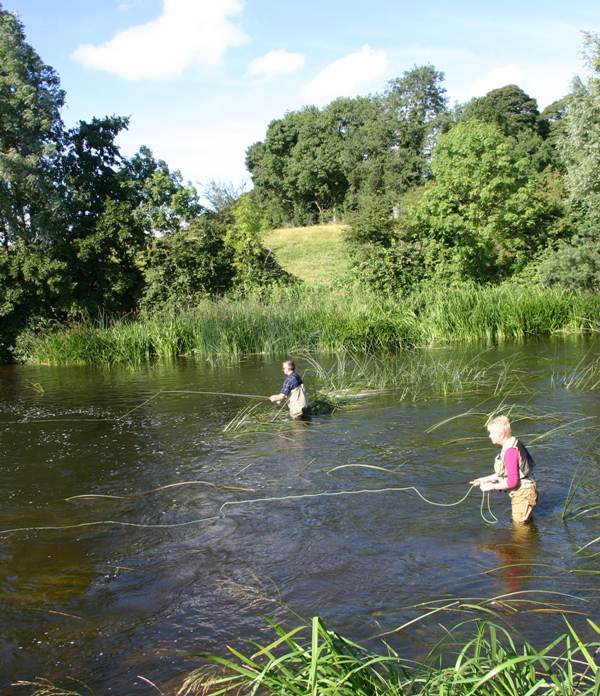
Trout fishing on the lower Boyne, County Meath.
Several of the major tributaries are notable brown trout fisheries including the Stoneyford and the Kells Blackwater.
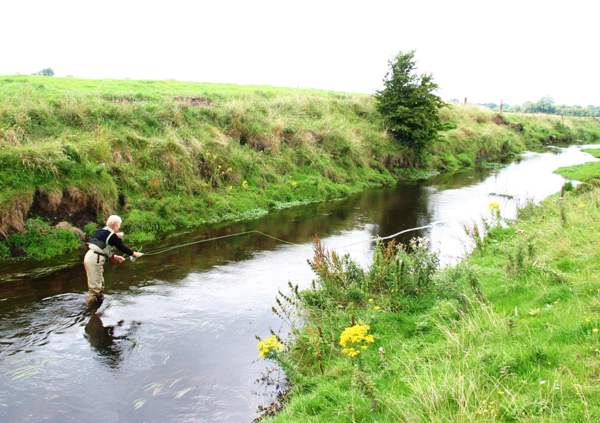
Sue Parker fishing on the Stoneyford
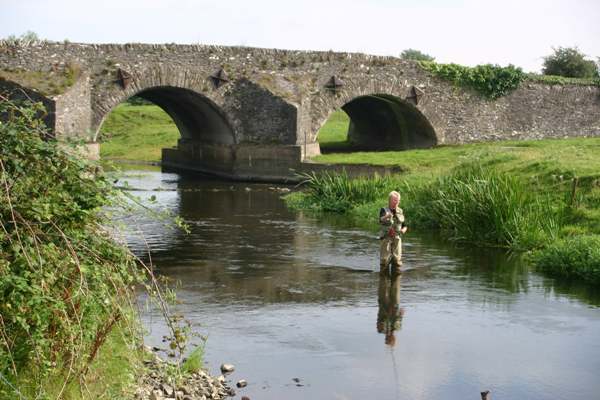
Flyfishing on the Kells Blackwater
Don't be fooled by the modest size of the Boyne tributaries; they hold some sizeable brown trout and provide excellent dry fly fishing!
River Moy
The Moy rises rises in the Ox Mountains of County Sligo, northwest Ireland, and flows south-west into County Mayo before turning north near Kilmore and heading through Ballina and thence into Killala Bay. The Moy is one of the best salmon fishing rivers in Europe, with a ten-year average catch of more than 7000 salmon per year. The weir at Ballina tends to trap fish in the Ridge Pool and to a lesser extent the adjacent Cathederal Pool, both in the town of Ballina, and a high proportion of the rod-caught fish on the Moy come from this area. Foxford, further upstream, is another wll-known salmon mecca.
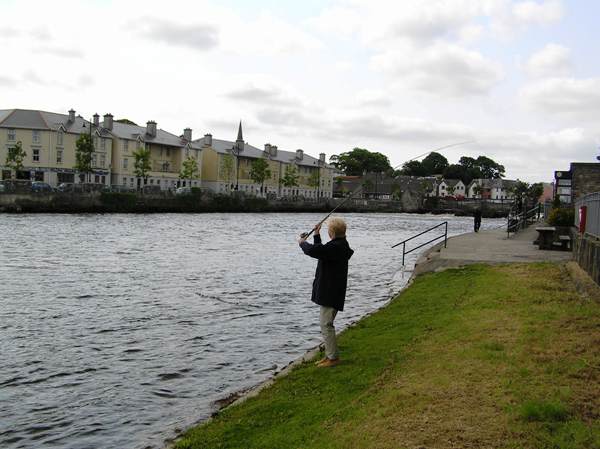
The famous Ridge Pool on the River Moy in Balina
Salmon and sea trout fishing
The Moy at Balina can be covered easily with a 15 ft rod. the main channel is deep and in all but low water a sink tip or even a fast-sinking line will be advantageous. Sea trout run the Moy, mainly towards the second half of the season, and most of them are in the 1 to 2 lb region, with a sprinkling of four pounders and the occasional bigger fish.
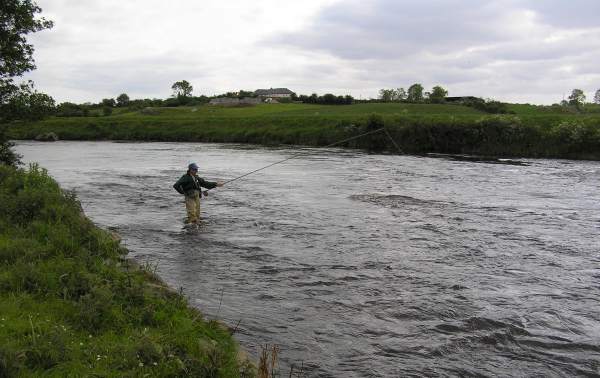
Salmon fishing on the Moy at Foxford
Popular flies for this river include the locally-devised patterns Ballina Grey and Foxford Shrimp, but an Ally’s Shrimp or a Gary Dog would probably be well worth a try.
River Slaney
The Slaney rises beneath the Wicklow Hills and flows some 75 miles southwards through Baltinglass, Rathvilly, Tullow, Bunclody and Enniscorthy before entering the Irish Sea at Wexford.
Salmon fishing
A noted spring salmon river, the Slaney still has its best runs in April, May and early June, with a few summer grilse and then some larger fish in September. A 13 ft rod is adequate on the lower Slaney, up as far as Tullow, above which point there is limited salmon fishing. Come equipped with a range of lines to suit the varying water conditions of springtime. A floater or intermediate will do in low water, but a Wetcell II or equivalent is necessary when rain has filled the river.
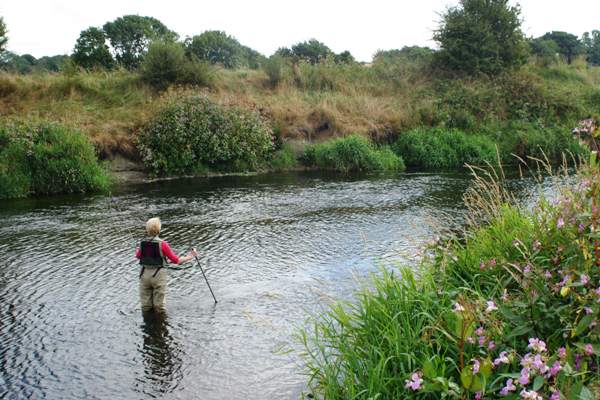
Salmon fishing near Bunclody
It takes three days or so for the Slaney to fine down after a spate, and fishing is best as the river is falling. A sink-tip line can be helpful when fish are running towards the end of a spate. Wading is difficult in all but drought conditions, but in most places there is room to cast from the banks. Spey casting skills are a great help, because the bank-side vegetation and bushes limit the opportunity for overhead casting.
Sea Trout Fishing
The lower and middle reaches of the Slaney offer excellent sea trout fishing, with most fish in the 1/2 to 2 pound region but with a sprinkling of three-to-four pound fish and the occasional bigger specimen. Night fishing with an intermediate or sink tip line can be very effective from June to the end of August, and single-hook flies in sizes 12 to 8 are popular with local anglers.
Trout Fishing
The Slaney from Tullow up to Baltinglass is an excellent wild trout fishery. The fish are small by Boyne or Fergus standards - a pound trout is a good one and the majority of adult fish are in the 1/2 to 3/4 lb region - but there are plenty of them anda few fish can always be found rising even on the hottest of summer days. The evening rise often brings up fish of well over a pound. The River between Rathvilly and Baltinglass has several very accessible stretches suitable for newcomers to river flyfishing.
There are a few mayflies in May and early June, but olives and summer sedges make up the main diet of Slaney trout for most of the season. (Pat O'Reilly's bestselling illustrated book Matching the Hatch covers all of these aspects.) In summer the water is usually gin clear, and so a long, fine leader is a great help. A 9ft rod rated at AFTM #5 or #6 is ideal.
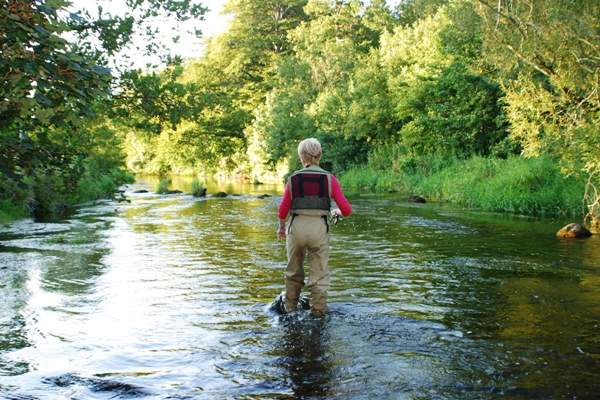
Sue Parker fishing for Slaney trout
Some stretches are tree-lined but there are many areas where you can cast from the bank. Wading is moderately easy above Rathvilly but more difficult around Tullow; chest waders are essential on most of the Slaney.
River Suir
The River Suir rises in the Devil's Bit Mountain and runs south to Cahir and then East, flowing through Clonmel and Carrick-on-Suir and then out to sea at Waterford Harbour.
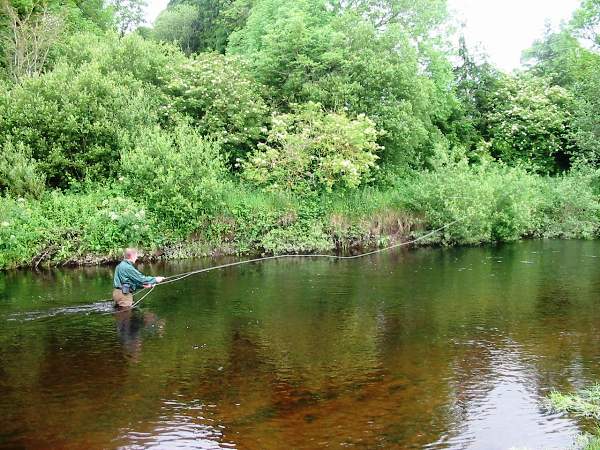
Upstream dry-fly fishing on the Suir in summer
Tributaries
The Suir's main tributaries are the Tar, Nire, Annagh, Aherlow, Multeen and Clodiagh. The Nire in particular is a great river for anyone new to trout fishing. Both the main river and the tributaries provide excellent trout fishing. In the lower reaches there are good numbers of sizeable trout whilst higher up the stock tends to be smaller but much more numerous.
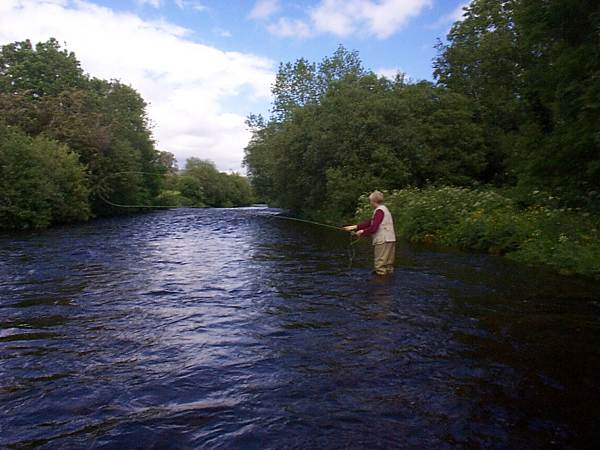
The Nire falls and clears qiuickly after rain, providing great sport when the main river is out of sorts
Trout fishing
The Suir is a freestone (rain-fed) river, but the relative uniformity of the riverbed makes it one of the easier rivers to wade - although care is needed because there are some very deep pools. The river flows mainly through farmland, and the banks are frequently tree-lined although not to the point where flyfishing is too difficult.
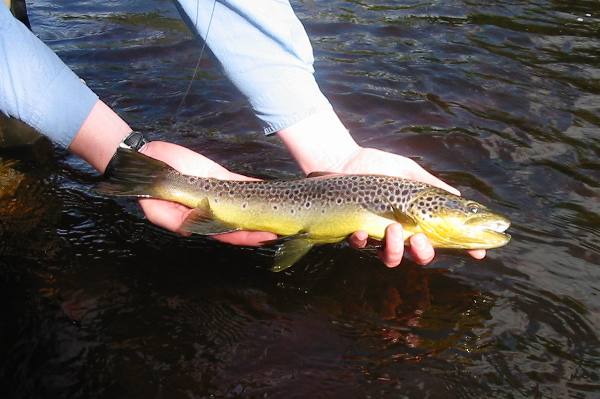
It's not just the main river that holds specimen fish; this lovely brown trout was caught (and released, of course) on the Nire
While the Suir is not famous for its mayfly hatches, which only occur between Camus Bridge and Golden, it does have prolific hatches of other insects of which the most important ones are sedges, hawthorn flies, olives, iron-blues, midges, reed smuts, caenis and pale wateries. (Pat O'Reilly's bestselling illustrated book Matching the Hatch covers all of these aspects.) On faster stretches of the river there are good stonefly hatches too.
Salmon fishing
Although generally known as a trout river, the Suir holds the distinction of producing Ireland's record for a rod-caught salmon weighing 57 lbs which was caught in 1874. The best salmon fishing is to be had downstream of Ardfinnan.
Most of the fishing on the Suir is controlled by syndicates and angling clubs.
Tackle
A good all round rod for trout fishing on the Suir would be a 9 ft or 9.5 ft AFTM #6 rod although an AFTM #4 or #5 not longer than 9ft would be useful for the tributaries, parts of which are completely tree-lined.
For Salmon fishing, a 15 ft double-handed AFTM #10 rod is adequate for most situations.
Excited at the prospect of flyfishing? So are we, and we're pretty sure you would find the Winding River Mystery trilogy of action-packed thrillers gripping reading too. Dead Drift, Dead Cert, and Dead End are Pat O'Reilly's latest river-and-flyfishing based novels, and now they are available in ebook format. Full details on our website here...
Buy each book for just £4.96 on Amazon...
Please Help Us: If you have found this information interesting and useful, please consider helping to keep First Nature online by making a small donation towards the web hosting and internet costs.
Any donations over and above the essential running costs will help support the conservation work of Plantlife, the Rivers Trust and charitable botanic gardens - as do author royalties and publisher proceeds from books by Pat and Sue.
